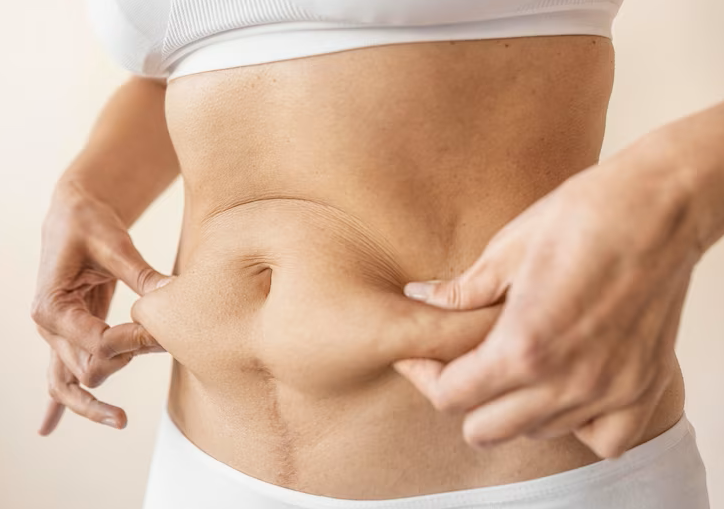Many individuals struggle with stubborn fat deposits that accumulate in specific areas of their body, causing frustration and a lack of confidence. One common problem area is the saddlebag region, located on the outer thighs and hips. Saddlebag fat can be particularly challenging to eliminate due to various factors, including genetics, hormones, and lifestyle choices. This article delves into the causes of saddlebag fat and explores options to help individuals achieve a more toned and proportionate physique.
Table of Contents
What Causes Saddlebag Fat?
Saddlebag fat, also known as lateral thigh fat, refers to the excess fat that accumulates around the outer thighs and hip area. The name “saddlebags” comes from the visual resemblance to the saddlebags placed on the back of horses. While the exact causes of saddlebag fat can vary from person-to-person, several key factors contribute to its development. These include:
Hormonal Influence
Hormones play a significant role in fat storage and distribution in the body. For women, hormonal fluctuations during puberty, pregnancy, and menopause can lead to an increased accumulation of fat in the saddlebag region.
The female hormone estrogen promotes fat storage around the hips and thighs, making it more challenging to lose weight in these areas.
Genetics
Genetic predisposition can determine how and where your body stores fat. Some individuals are genetically more prone to accumulating fat in the saddlebag area, regardless of their body weight or overall fitness level.
Sedentary Lifestyle
A lack of physical activity can lead to weight gain and fat accumulation in specific areas, including the saddlebags. Regular exercise helps burn calories, boost metabolism, and tone muscles, making it essential for overall body contouring.
Poor Diet
Consuming a diet high in processed foods, sugary beverages, and unhealthy fats can contribute to weight gain and the development of saddlebag fat. A diet rich in fruits, vegetables, lean proteins, and whole grains can help maintain a healthier weight and reduce fat deposits.
Age
As individuals age, their metabolism tends to slow down, making it more challenging to burn calories and fat efficiently. This age-related change can lead to the gradual buildup of saddlebag fat over time.
Non-surgical Body Contouring Solutions for Saddlebag Fat
While surgical procedures like liposuction can effectively remove saddlebag fat, non-surgical body contouring options have gained popularity due to their minimal invasiveness, quicker recovery times, and reduced risks. Below are some non-surgical methods to help get rid of saddlebag fat:
Cryolipolysis
Cryolipolysis is a non-invasive fat reduction technique that uses controlled cooling to freeze and destroy fat cells. Its most popular brand name is CoolSculpting®. The procedure targets specific areas, such as the saddlebags, without harming surrounding tissues.
Over the following weeks, the body naturally eliminates the damaged fat cells, resulting in a slimmer and more contoured appearance.
Radiofrequency (RF) Energy
Radiofrequency (RF) treatments use energy to heat the deep layers of the skin, promoting collagen production and tightening loose skin. Some RF devices can also target and reduce fat cells, making them an effective option for addressing saddlebag fat while improving skin texture and elasticity.
High-Intensity Focused Ultrasound (HIFU)
HIFU is a non-invasive treatment that delivers focused ultrasound energy to heat and destroy fat cells in the saddlebag area. Like RF treatments, HIFU can also stimulate collagen production, leading to skin tightening and firming effects.
Laser Lipolysis
Unlike traditional liposuction, laser lipolysis involves using lasers to liquefy fat cells before removing them from the body. This minimally invasive procedure can effectively target saddlebag fat while promoting skin tightening in the treated area.
Body Contouring Creams
Although not as effective as other non-surgical treatments, certain body contouring creams claim to reduce the appearance of saddlebag fat by promoting fat breakdown and metabolism. It is essential to research and choose products with clinically proven ingredients.
Exercises to Reduce Saddlebag Fat
In addition to non-surgical body contouring treatments, incorporating targeted exercises into your fitness routine can further aid in reducing saddlebag fat. Below are some effective exercises that focus on toning the outer thighs and hips:
Side Lunges
Side lunges target the muscles in your inner and outer thighs, helping to reduce saddlebag fat while also working the glutes and quads.
- Stand with your feet shoulder-width apart.
- Take a step to the side with your right foot, bending your right knee and pushing your hips back.
- Lower your body until your right thigh is parallel to the ground, keeping your left leg straight.
- Push off your right foot and return to the starting position.
- Repeat on the other side.
- Aim for 3 sets of 12-15 repetitions on each leg.
Side Leg Lifts
Side leg lifts directly engage the outer thigh muscles, providing an effective workout for the saddlebag area.
- Lie on your side with your legs stacked on top of each other.
- Rest your head on your bottom arm and place your top hand on the floor for support.
- Lift your top leg as high as you comfortably can, keeping it straight.
- Lower your leg back down without touching the bottom leg.
- Repeat on the same side before switching to the other side.
- Aim for 3 sets of 15-20 repetitions on each leg.
Sumo Squats
Sumo squats work the inner and outer thighs, as well as the glutes, providing a comprehensive lower body workout.
- Stand with your feet wider than shoulder-width apart and your toes pointed slightly outward.
- Lower your body into a squat position, keeping your knees aligned with your toes.
- Engage your glutes and inner thighs as you return to a standing position.
- Repeat for 3 sets of 12-15 repetitions.
Fire Hydrants
Fire hydrants target the outer hips and glutes, helping to tone and strengthen the saddlebag area.
- Get down on all fours with your hands directly under your shoulders and knees under your hips.
- Lift your right leg out to the side while keeping your knee bent at a 90-degree angle.
- Lower your leg back down without touching the ground and repeat the movement.
- Complete the desired repetitions on one side before switching to the other side.
- Aim for 3 sets of 15-20 repetitions on each leg.
Hip Abduction With Resistance Bands
This exercise utilizes resistance bands to increase the challenge and effectiveness of working the outer thighs.
- Place a resistance band just above your knees.
- Stand with your feet shoulder-width apart.
- Take a step to the side with your right foot, stretching the resistance band.
- Return to the starting position and repeat on the other side.
- Aim for 3 sets of 12-15 repetitions on each leg.
Remember, consistency is key when it comes to seeing results. Combine these exercises with cardiovascular activities like jogging, cycling, or dancing, as well as a balanced diet, to maximize fat loss and improve overall body composition.
It’s essential to consult with a fitness professional or healthcare provider before starting any new exercise routine, especially if you have any pre-existing medical conditions or concerns.
Saddlebag Fat Can be Battled With Body Contouring and Exercise
Saddlebag fat can be a frustrating concern for individuals striving to achieve a sculpted and toned physique. By understanding the factors that contribute to its development, such as hormones, genetics, lifestyle, and age, we make informed decisions about options to get rid of it. While surgical options like liposuction exist, non-surgical body contouring techniques offer a safer and less invasive alternative to target saddlebag fat.
Fitness exercises targeting saddlebag fat should also be incorporated. Maintaining a healthy lifestyle through regular exercise and a balanced diet will complement these non-surgical treatments, contributing to long-term success in reducing saddlebag fat and improving overall well-being.
Before pursuing any non-surgical body contouring treatment, it is crucial to consult with a qualified healthcare professional or aesthetic specialist. They can assess individual needs, recommend the most suitable treatment plan, and ensure the best possible outcome for achieving a smoother, more balanced silhouette.

